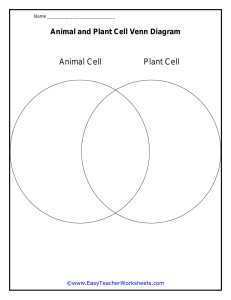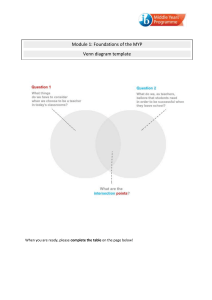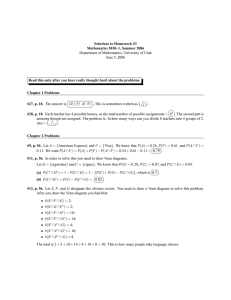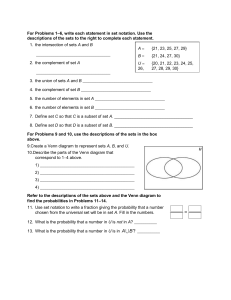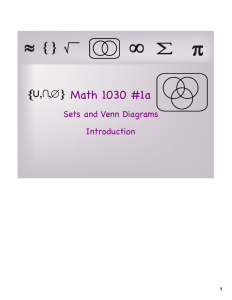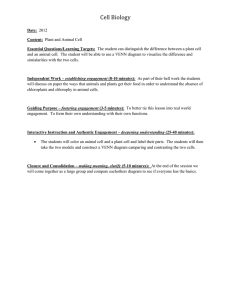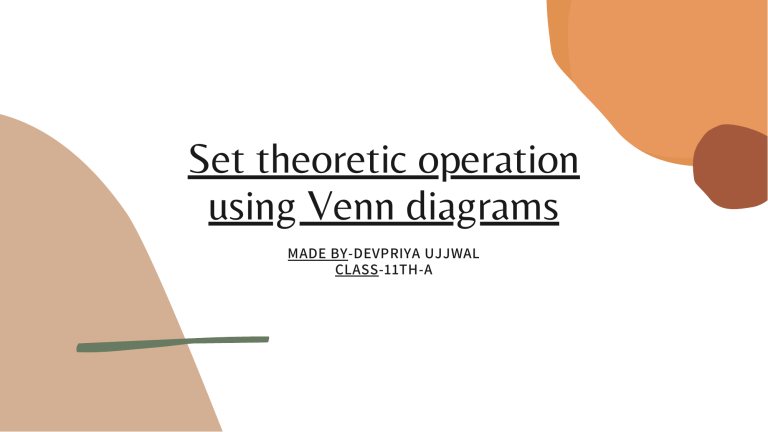
Set theoretic operation
using Venn diagrams
MADE BY-DEVPRIYA UJJWAL
CLASS-11TH-A
WHAT ARE SETS ?
In mathematics, a set is a collection of
distinct elements. The elements that make
up a set can be any kind of things: people,
letters of the alphabet, numbers, points in
space, lines, other geometrical shapes,
variables, or even other sets. Two sets are
equal if and only if they have precisely the
same elements. Sets, in mathematics, are an
organized collection of objects and can be
represented in set-builder form or roster
form. Usually, sets are represented in curly
braces {}, for example, A = {1,2,3,4} is a
set.
WHAT ARE VENN
DIAGRAMS ?
A Venn diagram is a widely-used diagram style that
shows the logical relation between sets, popularized
by John Venn in the 1880s. The diagrams are used to
teach elementary set theory, and to illustrate simple
set relationships in probability, logic, statistics,
linguistics and computer science.
UNION OF SETS
The union of two sets A and B is defined
as the set of elements which are either in
set A or set B or in both A and B. This
operation is denoted by the symbol.
∪
INTERSECTION OF SETS
In mathematics, the intersection of two sets A and B,
denoted by A B, is the set containing all elements of A
that also belong to B (or equivalently, all elements of B
that also belong to A). he set operation intersection takes
only the elements that are in both sets. The intersection
contains the elements that the two sets have in common.
The intersection is where the two sets overlap.
∩
COMPLEMENT OF SET
If U is a universal set and A be
any subset of U then the
complement of A is the set of
all members of the universal
set U which are not the
elements of A.
A′ = {x : x U and x A}
Alternatively it can be said that
the difference of the universal
set U and the subset A gives us
the complement of set A.
∈
∉
DISJOINT SET
A and B are disjoint.
Here, we observe that there is no
common element in A and B.
Therefore, n(A B) = n(A) + n(B)
∪
NOT A DISJOINT SET
When A and B are not disjoint, we have from
the figure
(i) n(A B) = n(A) + n(B) - n(A B)
(ii) n(A B) = n(A - B) + n(B - A) + n(A B)
(iii) n(A) = n(A - B) + n(A B)
(iv) n(B) = n(B - A) + n(A B)
∪
∪
∩
∩
∩
∩
DIFFERENCE OF A-B
Let A and B be two sets. The
difference of A and B, written as A - B,
is the set of all those elements of A
which do not belongs to B.
Thus A – B = {x : x A and x B}
or A – B = {x A : x B}.
Clearly, x A – B
x A and x B
In the adjoining figure the shaded part
represents A – B.
∈
∈ ∉
∈
⇒ ∈
∉
∉
DIFFERENCE OF B-A
Similarly, the difference B – A
is the set of all those
elements of B that do not
belongs to A.
Thus, B – A = {x : x A and x
B} or A – B = {x B : x
A}.
∉
∈
∈ ∉
VENN DIAGRAM
OF THREE SETS
The formula used to solve the
problems on Venn diagrams
with three sets is given below:
n(A ⋃ B ⋃ C) = n(A) + n(B) + n(C) – n(A
⋂ B) – n(B ⋂ C) – n(A ⋂ C) + n(A ⋂ B
⋂ C)
THREE SETS
SUBSET OF SET
In mathematics, a set A is a
subset of a set B if all elements
of A are also elements of B; B is
then a superset of A. It is
possible for A and B to be
equal; if they are unequal, then
A is a proper subset of B.
QUESTIONS ON VENN
DIAGRAM
>IN A SURVEY OF SCHOOL STUDENTS, 64 HAD TAKEN MATHEMATICS
COURSE, 94 HAD TAKEN CHEMISTRY COURSE, 58 HAD TAKEN
PHYSICS COURSE, 28 HAD TAKEN MATHEMATICS AND PHYSICS, 26
HAD TAKEN MATHEMATICS AND CHEMISTRY, 22 HAD TAKEN
CHEMISTRY AND PHYSICS COURSE, AND 14 HAD TAKEN ALL THE
THREE COURSES. FIND HOW MANY HAD TAKEN ONE COURSE ONLY.
From the Venn diagram above, we have- No. of students
who had taken only math = 24
No. of students who had taken only chemistry = 60
No. of students who had taken only physics = 22
Total no. of students who had taken only one course :=
24 + 60 + 22= 106 So, the total number of students who
had taken only one course is 106.
>In a school, 60 students enrolled in chemistry,40 in physics,
30 in biology, 15 in chemistry and physics,10 in physics and
biology, 5 in biology and chemistry. No one enrolled in all the
three. Find how many are enrolled in at least one of the
subjects.
From the Venn diagram,
number of students enrolled
in at least one of the subjects :
= 40 + 15 + 15 + 15 + 5 + 10 +
0
= 100
So, the number of students
enrolled in at least one of the
subjects is 100.
>In a school 85% of the people speak Tamil, 40% speak English and
20% speak Hindi. Also 32% speak Tamil and English, 13% speak Tamil
and Hindi and 10% speak English and Hindi, find the percentage of
people who can speak all the three languages.
From the Venn diagram, we can have
100 = 40 + x + 32 – x + x + 13 – x + 10 –
x–2+x–3+x
100 = 40 + 32 + 13 + 10 – 2 – 3 + x
100 = 95 – 5 + x
100 = 90 + x
x = 100 – 90 , x = 10%
So, the percentage of people who
speak all the three languages is 10%.
THANK YOU
MADE BY – DEVPRIYA UJJWAL
CLASS-11TH -A
